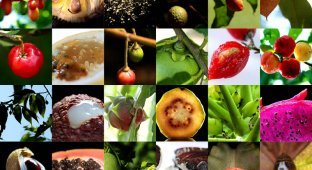Rambutan is a tropical fruit tree of the Sapindaceae family. The fruits are small, the size of a hazelnut, grow in clusters of up to 30 pieces and are rounded “balls” with an elastic peel of yellow or red color, covered with fleshy hairs 4-5 cm long. The pulp covering the stone (edible, but tastes like an acorn ), is a transparent white gelatinous mass with a pleasant sweet taste.

The Indian jackfruit, which is very similar to the breadfruit, has been grown in Thailand and other East Asian countries for many centuries.
All parts of jackfruit are edible. Blanched fruit flowers are added to hot capsicum or shrimp sauce. Young leaves can be added raw to papaya salad. Absolutely everything is used. Jackfruit pulp goes great with ice cream and other fruits and sweets, especially the pulp in coconut milk in the form of fruit salad. You can use jackfruit to make unusual fillings for pies and even cut and bake the fruit like vegetables.

Typically, passion fruit is oval or round, depending on the variety of fruit. Passion fruit is one of the juicy fruits. The unripe fruit is green in color, while the peel of ripe fruit can be purple, yellow or brownish-orange in different varieties of passion fruit. The peel of the fruit has a smooth surface and is divided into three layers. The pulp is a little bitter, but it has a great aroma. Inside each fruit there are many black seeds. Passion fruit grows well in cool climates. Peak yield occurs in October-November. (The diameter of the fruit is on average 4-7.5 cm.)

In the 17th century, Chinese emigrants brought the aromatic lychee fruit to Thailand, which had been grown in southern China for a long time. This fruit is very similar to rambutan and longan and grows in clusters on small evergreen trees that are no more than 10 meters high and have dense foliage. There are about 20 varieties of lychee grown in Thailand. Three of them are the most exported: hong huai, an oval-shaped fruit covered with a delicate yellowish-pinkish-red skin and having a sweet and at the same time slightly sour taste; kirn cheng, a spherical fruit of bright red color with small seeds, very sweet in taste; chakmphat, a large spherical, very sweet fruit, bright red in color with small seeds.

The carom has an oval shape, the fruit consists of 3-5 segments. If you cut the carom crosswise, the halves will resemble a star shape. The skin of the fruit is smooth and shiny, light green in color. When the carom ripens, it turns yellow. The juicy pulp of the fruit can have both a bitter and sweet taste, depending on the variety of carom. There are 8-12 grains inside each fruit. The carom harvest peaks in October and is grown throughout Thailand. Carambola contains carbohydrates, vitamin C, calcium and phosphorus. (The average diameter of the fruit is 5-8 cm, and the length is 10-12 cm.)

Often referred to as the “Queen of Tropical Fruits,” the mangosteen is believed to have originally been cultivated in Malaysia and later throughout South Asia. A traveler who visited Thailand in the 17th century describes the mangosteen as follows: “The heart of an ox is the name given to this fruit because of its shape and size; The peel of the mangosteen is thin, and the pulp, which the natives call mancout, resembles a cream, very pleasant to the taste.” Mangosteen, having a refined taste, as well as an attractive and exotic appearance, it is very popular in Thailand. The “native” variety of mangosteen has a round shape, the outside is characteristically dark purple, and the inside of the fruit has a pinkish peel, topped with a bunch of leaves. parts, at least there are three, but usually there are five or six, inside there is a white, sweet and aromatic pulp, the taste of which is something between a peach and a grape. You can play a guessing game: count the number of “flat segments” at the stem and. at the bottom of the fruit, and try to determine how many parts the fruit consists of.

A fresh, miniature orange-like fruit about the size of a very large olive. Used as decoration, but not always. This pygmy citrus family is grown in China, Japan and the USA. The edible orange ring is sweet in contrast to the sour and rather dry pulp. In general, the whole fruit can be eaten, although most ripe fruits are cut into slices and used for decoration, such as on the edges of salads or other dishes or drinks. Most often, this fruit can be found in cooked form: candied, pickled whole, or in the form of marmalade. Fresh fruits are available from November to March. Look for firm, undamaged fruit. You can store it in the refrigerator in a plastic container for about a month. This fruit contains significant amounts of vitamins A and C.

Durian, often called the “king of Thai fruits,” weighs from 2 to 10 kilograms, and the durian skin is studded with thorns of a menacing appearance and size. In Thailand and many Asian countries, durian is considered a delicious and even captivating fruit. It is well known that durians growing in Thailand are the most delicious in the world, so this is one of the most expensive but popular fruits in the markets.

Dragon fruit (Thai name - geow mangon) is a bright pink fruit the size of a very large apple, but slightly elongated in shape. Color - bright rich pink. The peel is large scales, and the edges of the “scales” are bright light green or green. If you peel the thin skin (slightly cut the skin with a knife and peel it like an orange), then inside you will find dense white, red or purple pulp with many small seeds, like a kiwi, which fills the entire volume.

This melon with horns was born in the Kalahari Desert. They say it is very tasty. In a pinch, it can be used to decorate a dish.























